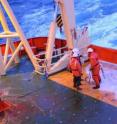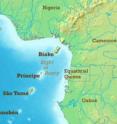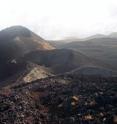Storms, soccer matches hidden in seismometer noise
Related images
(click to enlarge)
If you wander up to a seismograph in a museum, unless you are lucky enough to be there right during an earthquake, all you will see is a small wiggly signal being recorded. What's inside the wiggles is called noise by seismologists, because the signal is always there and originates from the normal activity of the earth between the jolts caused by large earthquakes.
Up until recently, few researchers paid any heed to these apparently boring signals – analyzing them, it was thought, would be like critiquing elevator music.
But now a seismologist and his adviser from Washington University in St. Louis, building on a serendipitous, humorous find of three years ago linking seismic noise and soccer, have discovered a source of seismic noise in Africa near the island of Bioko in the Bight of Bonny in the Gulf of Guinea. Improbable as it may seem the strength of this source varies with the intensity of storm activity in the Southern Atlantic Ocean. During the largest storms, seismic waves from the Bight of Bonny are recorded by broadband seismometers all around the world.
Washington University doctoral candidate Garrett Euler, using a mathematical technique called cross correlation, analyzed four arrays of broadband seismometers in Cameroon, South Africa, Ethiopia and Tanzania and found that seismic noise oscillating at 28 and 26 second periods originates in the Bight of Bonny and varies with the intensity of storm activity in the Southern Atlantic Ocean. During the largest storms, seismic waves from the Bight of Bonny are recorded by broadband seismometers all around the world.
Although the exact mechanism causing seismic noise near Africa is unknown, Euler speculates that long-period ocean waves from storms in the Southern Atlantic Ocean reflect off the coast of Africa and focus near the island of Bioko. The interaction of the waves with the shallow seafloor changes the ocean wave energy into seismic waves that travel through solid earth. The noise source was first discovered by Jack Oliver, PhD, of Columbia University in 1962, but Euler's work is the first to accurately locate the source.
"It's said that one researcher's noise is another's signal," says Euler's co-advisor Douglas A. Wiens, PhD, professor and chair of Washington University's earth and planetary sciences department in Arts & Sciences. "When we don't understand it, we call it noise. When we do, we call it a signal. In the past, this kind of data didn't stick out at all, but just recently people are coming to grips with how to analyze it. There are intriguing possibilities for what noise might reveal."
Although seismic noise analysis is still developing, some seismologists are modeling noise to look for a signature that could reveal a global warming effect. For instance, as the number of storms increase, perhaps there are corresponding fluctuations in seismic noise. Others are considering using seismic noise to map volcanic magma chambers. There has even been some very preliminary work exploring the possibility that seismic noise might predict earthquakes. The idea is that the wave speed of a region might change as stress builds up before an earthquake.
Euler gave a presentation on his observations at the fall meeting of the American Geophysical Union in San Francisco this December.
"We have some very bizarre observations that we're still trying to figure out," says Euler, of his initial data. "One is the signal is at longer periods than we'd expected. It has multiple peaks in frequency — it 'hums' at 28 seconds, as well as 26 seconds. It's really, really strong during some particular times that correlate with storms at sea.
"Another observation is that the signal shifts its location with frequency. The source of the 28-second period band is about 300 kilometers from the 26-second source, which is essentially at Mount Cameroon."
Cross correlation compares the similarity of two seismic signals, usually recorded at two different locations, as a function of the time lag between them — essentially sliding one signal past the other until they match up. Peaks in the correlation function correspond to the average seismic velocity between the two locations. To cross correlate seismic noise, though, Euler faces a conundrum because there is no well-defined termination of seismic noise.
"This noise is made up of a cacophony of overlapping signals across quite long seismic records that have to be averaged, and that information comprises this noise field," he says.
Euler wandered into the field of seismic noise in 2007 when he found consistent spikes in noise from one of 32 different seismic stations in Cameroon. The spikes turned out to correspond with joyous, celebratory foot-stomping of Cameroon's avid soccer fans at various cities after goals were scored or key plays made during the African Cup of Nations games in 2006.
This was the first time widespread anthropogenic noise — created by humans — had been found in seismic signals. And it was the first known reporting of "footquakes."
"When I got that data, I was stumped, because there hadn't been any earthquakes recorded during that time," he says. "We finally put two and two together and saw this as the result of thousands of fans spread out over many miles, reacting to things ranging from a goal, to the reaction of a star player, to the ultimate, a win. There were slight fluctuations in all the scenarios. That was the start of my interest in seismic noise. It's grown a lot since."
Source: Washington University in St. Louis
Other sources
- Seismometer noise includes signals from South Atlantic storms, 'footquakes' from soccer matchesfrom PhysorgMon, 17 Jan 2011, 17:32:24 UTC


